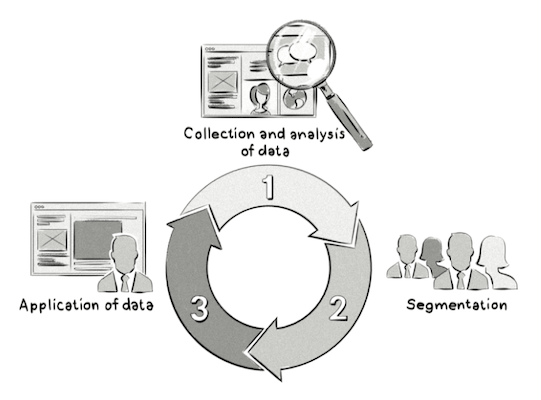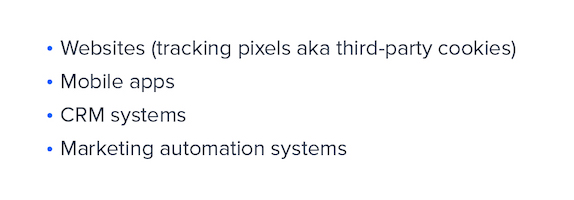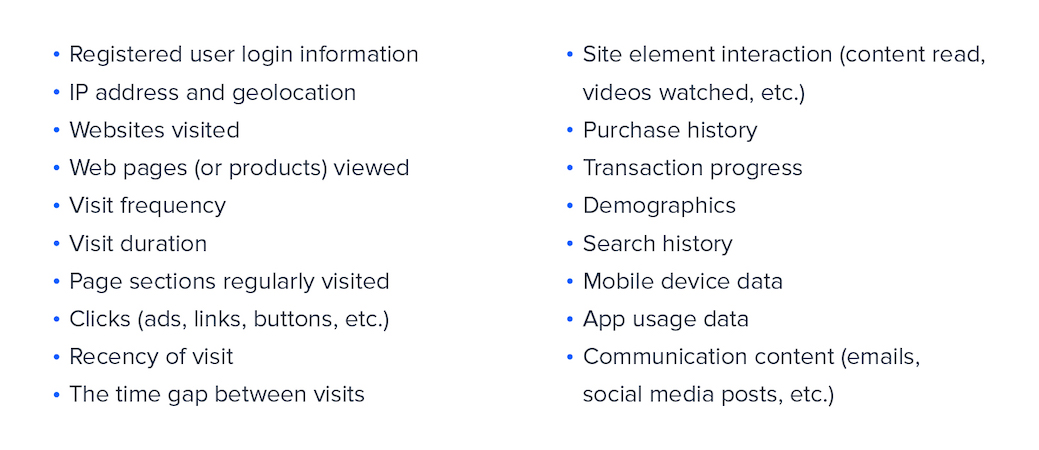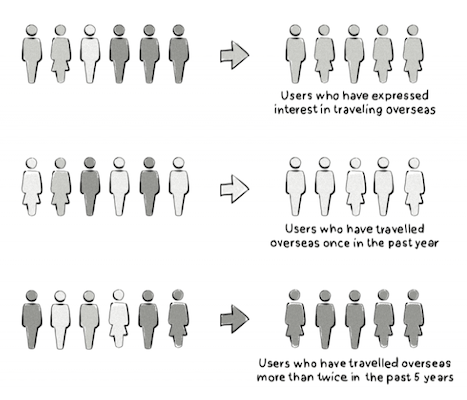- What is behavioral advertising?
- How does it work?
- Data collection & analysis
- User segmentation
- Behavioral targeting application
- Pro #1: More relevant offers
- Pro #2: Higher efficiency in online shopping
- Pro #3: Better retargeting
- Pro #4: Improved metrics for advertisers
- Con #1: Negative consumer responses
- Con #2: Personal information exploitation
- The alternative is contextual
- Conclusion
For years, publishers and advertisers have taken advantage of user data to segment their audiences by demographics, geography, etc. — and therefore increase the relevance of online ads displayed to those audiences.
More recent technologies have further advanced the way brands serve segmented, personalized offers to their audiences — with online behavioral advertising.
However, although advertisers and service providers can increase their ad revenue from the practice, it also raises concerns about consumer privacy. In this post, we’ll take a closer look at what behavioral-targeted advertising is, how it works, and the pros and cons of this online advertising technique.
What is behavioral advertising?
Behavioral advertising (aka online behavioral advertising or “OBA”) allows advertisers and publishers to display highly relevant ads and personalized marketing messages to users based on their web-browsing behavior. The primary purpose is to deliver targeted ads to the behavioral market segments most likely to be interested.
Example: An advertising network (Facebook, in this example) tracks a consumer’s website visits and sees they visit several fitness websites. Naturally, the network assumes the consumer is interested in fitness and displays related ads:

For someone not uninterested in fitness, though, this wouldn’t show. So consequently, when two people visit the same website at the same time, one may see fitness ads while the other (who is more interested in home decor, for instance) may see home decor ads.
How does online behavioral advertising work?
The behavioral targeting process can be broken down into three main steps:

1. Data collection and analysis
User data is collected from a range of sources:

And can include:

Data is stored, organized, and aggregated in a data management platform (DMP) or other adtech platform such as a DSP until enough has been collected to create specific user segments:

2. User segmentation
As data is collected, stored, and analyzed, behavioral patterns start to form and user segments are created:

This allows publishers and advertisers to focus their ads on the individual audience segments most likely to be interested.
3. Behavioral targeting application
Once audience segments are created, behavioral targeting can be applied to campaigns to make ads more relevant to specific groups:

Instead of receiving random ads, consumers will see custom content and personalized banner or social media ads that draw from their own past behaviors, increasing the likelihood of engagement and conversions.
Behavioral advertising pros and cons
OBA has received both positive and negative attention from advertisers, consumers, and policymakers. To help you form your own opinion, here’s a look at the major pros and cons to the consumer as well as for digital advertisers.
Pros
1. More relevant offers for consumers
OBA differs from other online advertising because it aims at personal relevance. Between online activity tracking, data collection, audience segmentation, and information dissemination, this type of advertising works because it serves users with extremely personalized and relevant ads, leading to an overall better user experience.
2. Higher efficiency in online shopping
When consumers see ads for products that interest them, it’s easier for them to click through and be automatically redirected to online storefronts, than navigating to the website themselves. From there, adding the item to their shopping cart and proceeding to a checkout page likely only involves a few more steps, making the entire online shopping experience more efficient and enjoyable.
3. Better retargeting
Retargeting is effective in any ad campaign, but it’s a useful subset of behavioral targeting. Behavioral retargeting ads focus on using online behavioral data to persuade users to return to a website they’ve already visited, or re-engage with a brand they’ve already engaged with. For example, after visiting the Bali Body website, this Facebook retargeting ad showed up:

Behavioral retargeting ads also serve as reminders and alerts. By continually seeing ads for products or brands they’re interested in, users can stay up to date with new releases, announcements, and other relevant information. Also, if a user was distracted from completing an online purchase, a behavioral retargeting ad may remind them to finish the transaction.
4. Improved metrics for advertisers
The previous three benefits naturally help make ads more interesting and appealing to users. Personalized, relevant, convenient ads lead to higher overall user satisfaction — which, in turn, means higher CTRs, better conversion rates, and a large ROI for advertisers.
Note: This also depends on various advertiser-controlled factors (such as transparency about the invasion advertising practices used) and consumer-related factors (such as trust in the advertiser, privacy concerns, perceived usefulness of the ad, feelings of intrusiveness, etc.).
Cons
1. Negative consumer responses
Many internet users express widespread fear and loathing of the ad industry’s creepy data collection practices — so much that the usage of ad blockers has continued to increase annually, with nearly a third of the online population using ad blockers.
Negative responses to extreme personalization tend to stem from choice, psychological ownership, and psychological reactance theory — all suggesting that people form negative feelings about something when they feel their freedom of choice, control, and ownership are threatened. And the sense of invasion of online privacy by the advertising industry to display highly targeted ads leads people to perceive a loss of choice, control, or ownership.
2. Personal information exploitation
Critics of behavioral digital advertising feel the practice relies solely on mass scale exploitation of personal data to function, and will soon be in breach of the GDPR public policy — even despite the Digital Advertising Alliance (DAA) self-regulatory program.
While the practice hasn’t been ruled illegal yet (Google and Facebook use behavioral advertising frequently) there has been legal pressure applied via GDPR complaints. People claim the entire process should be illegal because it leaks personal data at such a vast and systematic scale and doesn’t comply with EU data protection law.
Although there are fewer cons than pros — they’re not cons that should be taken lightly. If advertisers decide to forgo behavioral advertising in this post-GDPR era, what can take its place and still display the right messages to the right people at the right times?
Contextual advertising as an alternative
Contextual and behavioral targeting are similar, albeit not the same. Whereas behavioral advertising tracks surfing behaviors, contextual ads are determined by the environment in which the audience is browsing.
The advantage contextual targeting has its compliance with the GDPR due to its minimal reliance on intimate personal details to serve relevant ads. This makes it safer for advertisers who want to avoid the GDPR (provided they don’t collect or use any personal data), while still benefiting from relevant advertising. In fact, when GDPR took effect, many publishers shifted from behavioral to contextual advertising and saw improved ROI.
Is behavioral advertising the right choice?
It’s certainly possible to increase your click-through rates, conversion rates, and ROI with behavior-targeted ads. However, it’s also feasible you’ll hurt your metrics if you come off overly invasive. Weigh the pros and cons of using behavioral advertising in your campaigns and decide whether you’ll use behavioral or contextual ads.
No matter your decision, remember you increase your chances of conversion with a personalized landing page. To maintain a high level of relevance throughout your entire campaign, connect every behavioral or contextual ad to its own unique landing page.
Request an Instapage 14-day free trial today to discover how to scale your landing pages.

Try the world's most advanced landing page platform with a risk-free trial.
